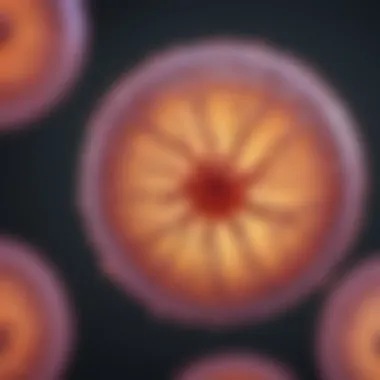Stem Cells in Ulcerative Colitis: Innovative Treatment Insights


Intro
Ulcerative colitis presents a particularly challenging landscape for both patients and healthcare providers. This chronic inflammatory bowel disease can take a significant toll not only on physical health but also on quality of life. Despite the advancements in treatments, the quest for a more effective solution continues. The exploration of stem cells as a potential remedy is taking center stage in research circles, providing new hope for improved management of this condition.
In recent years, there has been a surge of interest in harnessing the regenerative abilities of stem cells. This article will sift through the latest findings and methodologies in the realm of stem cell therapy for ulcerative colitis. By delving into the biological mechanisms and clinical applications, it seeks to bridge the gap between theoretical understanding and practical application, powered by cutting-edge research.
Through this discussion, students, practitioners, and researchers alike will gain deeper insights into how stem cells could reshape the treatment landscape for ulcerative colitis. The synergy of scientific inquiry and clinical applicability serves as the foundation for the narrative to follow.
Research Highlights
Overview of Key Findings
The investigation into stem cell therapy for ulcerative colitis yields several promising findings. Recent studies have shown that stem cells can potentially modulate the immune response, reduce inflammation, and promote healing of the intestinal lining. Notably, evidence suggests that mesenchymal stem cells (MSCs) play a pivotal role in achieving these outcomes. Their ability to release anti-inflammatory cytokines appears crucial in this regard.
Key research highlights include:
- Mesenchymal Stem Cells: MSCs have shown effectiveness in re-establishing mucosal integrity, hinting at their therapeutic potential.
- Clinical Trials: Several ongoing trials indicate positive results, with patients experiencing fewer flare-ups and improved overall health metrics.
- Mechanistic Insights: Investigations suggest that stem cells might initiate a cascade of repair by modulating gut microbiota in ways that conventional therapies do not.
Significance of the Research
This research is not just an academic exercise; its implications stretch directly into clinical practice. The ability to offer patients a more sustainable management solution holds transformative potential. With ulcerative colitis often leading to debilitating symptoms and surgical interventions, discovering a biological approach could alleviate much of the burden.
Furthermore, by navigating the complexities of stem cell interactions within the gastrointestinal tract, researchers may unlock broader applications within other inflammatory diseases. Thus, the significance extends far beyond the immediate context of ulcerative colitis, challenging existing paradigms in how chronic inflammatory conditions are perceived and treated.
"The emerging role of stem cells in treating ulcerative colitis could represent a paradigm shift in the management of chronic intestinal diseases, offering insights that may apply across a spectrum of related conditions."
Original Research Articles
Summary of the Article
The body of research encompassing stem cell therapy for ulcerative colitis varies in scope and approach. It includes exploratory studies examining the physiological underpinnings and randomized controlled trials assessing treatment efficacy. Notably, a recent article published in Nature Reviews Gastroenterology & Hepatology outlines the mechanisms whereby stem cells contribute to mucosal healing and inflammation reduction.
Author Contributions
The contributions of researchers in this field cannot be overstated. From bench to bedside, the collaboration between molecular biologists, gastroenterologists, and clinical researchers has been vital. Each plays a unique role in advancing understanding and refining methodologies for patient treatment. Through joint ventures, innovative treatment protocols are being developed with an eye towards enhancing patient outcomes.
In principle, this exploration into stem cell applications represents a blend of hope and rigorous scientific inquiry, paving the way for more robust treatment options in the near future.
Foreword to Ulcerative Colitis
In navigating the complicated landscape of gastrointestinal diseases, ulcerative colitis (UC) occupies a particularly significant position. This condition, characterized by chronic inflammation of the colon, not only impacts the physical well-being of individuals but also their psychological and social aspects. Understanding UC's nuances is key, as it opens pathways for innovative treatments, including the exciting realm of stem cell therapy.
Definition and Overview
Ulcerative colitis is a type of inflammatory bowel disease (IBD) that primarily involves the colon and rectum. It manifests as superficial lesions in the intestinal lining, leading to symptoms like abdominal pain, diarrhea, and weight loss. It's important to distinguish UC from Crohn's disease, another form of IBD, as the pathologies and management strategies differ. Patients with UC experience periods of exacerbation and remission, leading to a sense of unpredictability in their lives. The complexity of managing UC demands a multifaceted approach, addressing both the symptoms and their root causes.
Epidemiology and Prevalence
The prevalence of ulcerative colitis has been rising globally. In the United States, approximately 1 million individuals are diagnosed with either UC or Crohn's disease. The condition often begins in young adulthood, but it can affect individuals at any age. Research shows that genetic factors play a considerable role, as families with a history of IBD frequently see recurrent cases. Environmental triggers such as diet, infections, and stress are also under scrutiny. Notably, countries with industrialized lifestyles observe higher rates of UC, suggesting that lifestyle and environment might influence disease onset.
Symptoms and Diagnosis
Symptoms of ulcerative colitis can vary widely but often include:
- Abdominal cramping
- Bloody diarrhea
- Urgency to defecate
- Fatigue
- Weight loss
The diagnosis process typically begins with a thorough medical history and a physical examination. Physicians may employ endoscopy to directly visualize the colon and collect biopsies for histological examination. Blood tests and imaging studies are also utilized to assess inflammation levels and rule out other conditions.
"Early detection is crucial; a timely diagnosis can significantly impact a patient's quality of life and treatment options."
This comprehensive understanding of ulcerative colitis forms the bedrock for exploring innovative treatment avenues, including the promising role of stem cell therapy. As we delve deeper into this subject, we will connect the dots between our understanding of UC and the groundbreaking potential offered by stem cells.
Understanding Stem Cells
Stem cells represent a fascinating frontier in medical science. Their unique ability to differentiate into various cell types makes them pivotal in treating numerous diseases, including ulcerative colitis. This section will shed light on the different types of stem cells and how they can be harnessed for innovative treatments in the context of this inflammatory bowel disease.
Types of Stem Cells
Embryonic Stem Cells
Embryonic stem cells (ESCs) stand out due to their remarkable versatility. Derived from the blastocyst stage of embryonic development, these cells can transform into virtually any cell type in the body. This unique characteristic makes them a powerful tool in regenerative medicine.
One of the most significant advantages of ESCs is their pluripotency, which allows for the creation of tissues that may be damaged due to diseases such as ulcerative colitis. However, ethical considerations surrounding their use often spark debate within scientific and public circles. The ability to derive ESCs from donated embryos raises concerns about the moral implications of embryo destruction. Despite this, their potential for developing therapies that could restore healthy cellular function in the intestine cannot be overlooked.
Adult Stem Cells
Adult stem cells, often called somatic stem cells, are found in various tissues, such as bone marrow and adipose (fat) tissue. Unlike ESCs, adult stem cells have a more limited ability to differentiate into different cell types. Their primary role is to maintain and repair the tissues in which they reside.
The prominence of these cells in current research stems from their inherent qualities that make them less controversial compared to ESCs. Since they can be harvested from the patients themselves, the risk of rejection is significantly lower. However, they may not provide the same breadth of regenerative capabilities as ESCs, limiting their use in severe cases of ulcerative colitis.
Induced Pluripotent Stem Cells
Induced pluripotent stem cells (iPSCs) are a groundbreaking development in stem cell research. These cells can be generated by reprogramming adult somatic cells, effectively giving them the ability to behave like embryonic stem cells. This means they can differentiate into almost any cell type without ethical concerns associated with embryos. Their induced pluripotency represents a significant leap toward personalized medicine in treating conditions such as ulcerative colitis.
The potential of iPSCs lies in their ability to create patient-specific cell lines. This could lead to tailored therapies that address the unique profile of individual patients, minimizing the risk of adverse reactions. That said, the process of reprogramming can sometimes lead to genetic abnormalities, raising questions about their long-term safety and efficacy.


Stem Cell Differentiation
Stem cell differentiation is crucial for harnessing the therapeutic potential of stem cells. Differentiation refers to the process by which stem cells develop into specialized cells with specific functions. This section will explore various factors influencing differentiation and how understanding this process can optimize treatment strategies against ulcerative colitis.
Mechanisms of Action
Understanding the mechanisms through which stem cells operate provides insights into their therapeutic potential. Stem cells can influence healing processes directly and indirectly. They can secrete growth factors that promote tissue repair and reduce inflammation, which are key in conditions like ulcerative colitis. This part will outline the key pathways involved in the action of stem cells within the context of inflammatory bowel disease.
"Stem cells could potentially reshape our approach to treating chronic diseases, laying a solid foundation for pioneering therapies in the years ahead."
With a solid grasp of what stem cells are and the variety they present, we can now delve deeper into the implications of their mechanisms and differentiation for treating ulcerative colitis efficiently.
The Pathophysiology of Ulcerative Colitis
Understanding the pathophysiology of ulcerative colitis is crucial for grasping how stem cell therapies can potentially lead to innovative treatments. This chronic inflammatory bowel disease is marked by the inflammation of the colon's lining, which can cause a myriad of symptoms that impact an individual's quality of life. Unpicking the layers of its pathophysiology not only elucidates the mechanisms behind the disease but also indicates how emerging therapies could improve management outcomes.
Immune System Dysfunction
At the heart of ulcerative colitis lies an intricate dance involving the immune system. Normally, our immune system brushes off minor irritants without breaking a sweat. However, for those with ulcerative colitis, the immune system goes haywire. Something triggers the immune cells to launch an assault on the gut's mucosal layer, mistaking beneficial microbiota for adversaries.
This misfire results in chronic inflammation. As the body continuously fights against what it perceives as a threat, it leads to the destruction of increasingly healthy tissue. T lymphocytes, tumor necrosis factor (TNF), and other inflammatory mediators flood the area, keeping the cycle of damage alive. Researchers believe that addressing this immune dysfunction via stem cell therapy could recalibrate the immune response, thereby alleviating the inflammation and restoring balance in the gut.
Genetic and Environmental Factors
The interplay between genetic predisposition and environmental influences is fundamental in understanding ulcerative colitis. Familial histories often reveal a pattern; around 10% of cases have a direct family link, while genetic mutations related to immune responses have been identified.
Yet, possession of a genetic marker doesn’t guarantee the onset of the disease. Environmental factors like diet, stress, and exposure to certain pathogens also play pivotal roles in triggering symptoms.
- Genetic Factors:
- Environmental Factors:
- Certain mutations in genes associated with immune response
- Family history of inflammatory bowel diseases
- Dietary influences such as high-fat diets
- Microbial exposure
- Psychosocial stressors
The combination suggests a biopsychosocial model where both biological and lifestyle factors intertwine. This knowledge implies that effective therapies, including stem cell approaches, may need to address both dimensions to yield significant improvements.
Inflammatory Processes and Mucosal Damage
The inflammatory processes involved in ulcerative colitis and the consequent mucosal damage are substantial. As the immune system persists in its attack, the mucosal integrity begins to deteriorate. Epithelial cells, which are meant to provide a strong barrier against pathogens and toxins, falter under continuous assault. This loss of barrier function can lead to even more pronounced symptoms like diarrhea, pain, and in severe cases, gastrointestinal bleeding.
The cyclic nature of inflammation and repair means that while some degree of healing might occur, it’s often overshadowed by ongoing damage. The resultant situation can lead to ulcer formation in the colon. Stem cell therapy aims to mitigate this injury by promoting healing processes and regenerating damaged tissue, creating a new avenue in confronting this relentless cycle of destruction.
“The pathophysiology of ulcerative colitis serves as a roadmap for innovative treatments that could harness the body's innate repair mechanisms.”
In summary, the pathophysiology of ulcerative colitis encapsulates a multifaceted interplay of immune dysfunction, genetic susceptibilities, environmental factors, and inflammatory processes leading to mucosal damage. Understanding these dimensions provides the groundwork for discussions related to stem cell therapies and other evolving treatment modalities.
Current Treatment Approaches for Ulcerative Colitis
Understanding the existing treatment methods for ulcerative colitis (UC) is crucial, as it sets the stage for exploring how stem cell therapy may offer novel solutions. Current approaches are aimed at managing symptoms, inducing and maintaining remission, and preventing complications. This article highlights the importance of current treatments, focusing on their benefits and limitations that give rise to the need for alternative strategies like stem cell therapy.
Medications and Their Limitations
Medications for UC generally fall into a few categories, including aminosalicylates, corticosteroids, immunomodulators, and biologics. Each type of medication has its own strengths and weaknesses. For instance, aminosalicylates are often the first line of defense. They help reduce inflammation but aren’t always effective for all patients. Corticosteroids can rapidly control flare-ups but come with serious side effects, such as increased infection risk and weight gain.
Immunomodulators, which modify the immune response, also play an important role. However, they may take weeks to months to show benefits, leaving patients vulnerable in the meantime. Biologics have emerged as a game-changing option, targeting specific pathways in the inflammatory process. Yet, these drugs can be costly and might not be universally accessible or effective for everyone.
Thus, many patients experience ongoing discomfort or complications, emphasizing the limitations of current pharmacological treatments.
Surgical Interventions
Surgery represents a more drastic, albeit effective treatment option for some. In severe cases of UC where medication fails to control symptoms, options like proctocolectomy may be considered. Proctocolectomy involves removing the colon and rectum, which can essentially cure UC but may require the creation of an ileostomy, with its own set of lifestyle implications.
While surgery can significantly improve quality of life and relieve symptoms for some, it is not without risks. Complications such as bowel obstruction, infection, or surgery-related issues can plague surgery patients. Additionally, this route does not address the underlying mechanisms of UC, but rather removes the affected organs.
Emerging Therapies
As medicine advances, emerging therapies for UC show promise in addressing the shortcomings of current treatments. These novel approaches include advanced biologics, fecal microbiota transplantation (FMT), and even small molecules that target specific inflammatory pathways. For instance, FMT aims to restore a balanced gut microbiome, which some studies suggest may influence disease activity positively. Still, its efficacy can vary, leading to further questions about patient selection and protocols.
Research continues to explore these potential treatments, along with stem cell therapy, as an adjunct or alternative to traditional methods. By bridging current practices with innovative solutions, there lies a hope that future treatment exploring stem cells may address inflammatory bowel disease from a fresh perspective, offering real change for those who suffer from UC.
"The need for effective and tailored treatments for ulcerative colitis has never been more urgent, as existing methods often fall short of providing lasting relief."
In summary, while current treatment approaches serve vital roles, they are laden with limitations that necessitate the exploration of newer options like stem cell therapy for ulcerative colitis. The limitations of medications and the drastic nature of surgical interventions underscore the importance of pursuing innovative therapeutic avenues.
Stem Cells as a Treatment Option
Stem cell therapy is being recognized as a game-changer in many medical fields, and its significance in treating ulcerative colitis cannot be underestimated. The advances in stem cell research are unearthing promising avenues for addressing the multifaceted challenges posed by this chronic inflammatory bowel disease. Stem cells possess the unique ability to regenerate damaged tissues, and in the context of ulcerative colitis, they may help restore normal function to the inflamed intestinal lining.
A pivotal benefit of choosing stem cells as a therapeutic option is their regenerative capabilities. Unlike conventional treatments, which often focus on symptom management, stem cells could potentially heal and restore the intestinal barrier function. This capability fundamentally shifts the paradigm of treatment, moving from merely managing the disease to possibly curing it.
However, several considerations come into play when discussing stem cell therapy. Firstly, the type of stem cells used can influence the treatment outcomes. Various sources, such as embryonic or adult stem cells, may exhibit distinct behaviors and efficacy. Additionally, though the promise is significant, practical hurdles like ethical issues, safety concerns, and regulatory challenges must be addressed.
In contemplating the integration of stem cells into treatment plans, one must weigh these factors carefully. While the possible regenerative benefits are intriguing, the complexities surrounding implementation cannot be overlooked.
Mechanisms of Stem Cell Therapy


The underlying mechanisms through which stem cell therapy may exert its effects in ulcerative colitis are still being unraveled. Stem cells can migrate to damaged tissues, where they secrete factors that promote healing, reduce inflammation, and modulate immune responses. This complex interplay helps in mitigating the inflammatory cascade characteristic of ulcerative colitis.
One notable aspect is the possibility of stem cells differentiating into specialized cells of the intestinal lining. As they replace damaged cells, the restoration of normal architecture may occur, leading to improved gut function and a reduction in symptoms. This regenerative potential is supported by various studies demonstrating that stem cells can lead to a significant decrease in inflammatory markers and promote mucosal healing.
Preclinical Studies and Findings
Preclinical studies have provided crucial insights into the potential of stem cell therapy for ulcerative colitis. In animal models, treatments with stem cells have shown promising results, with significant improvements in parameters such as histological damage scores and clinical symptoms. For instance, mesenchymal stem cells have been observed to effectively reduce inflammation and promote healing of the colonic epithelium.
Additionally, specific studies have indicated that stem cells can enhance the gut microbiota, which is crucial for intestinal health. By supporting a balanced microbiome, stem cells may help in creating a more favorable environment for healing, further establishing their role as a vital therapeutic option.
Clinical Trials and Outcomes
Ongoing Trials
Ongoing clinical trials are a vital component of understanding stem cell therapy's role in treating ulcerative colitis. One notable feature of these trials is their diversity in design, ranging from assessing the safety of stem cells to evaluating their efficacy in reducing inflammation. The ongoing trials are extensive, often prioritizing patient-specific needs, which adds to their relevance.
These trials contribute significantly to the evolving landscape of treatment options. They pave the way for fine-tuning the methodologies used in stem cell therapy, which will ultimately enhance outcomes. Moreover, ongoing studies often feature innovative protocols, including combining stem cell therapy with other treatments, enabling research into synergies that could amplify therapeutic effectiveness.
Completed Studies
Completed studies have already laid down a foundation of evidence supporting the use of stem cell therapy in ulcerative colitis. A key characteristic of these studies is that they offer longitudinal data, showing how patients responded to treatments over time. This long-term data is invaluable because it not only addresses short-term outcomes but also sheds light on possible long-term benefits and risks associated with stem cell therapy.
In particular, completed studies have reported notable improvements in patients' quality of life alongside clinical remission rates. However, these studies also underscore the need for ongoing observation to carefully monitor any potential adverse effects as treatment progresses.
The unique feature of completed studies lies in their capacity to inform best practices for future interventions. They serve as critical learning experiences, shaping the direction of future trials and enhancing our understanding of the optimal ways to deploy stem cell therapies effectively.
By effectively weaving together the strands of ongoing and completed studies, we begin to see a clearer picture of how stem cells might redefine the treatment landscape of ulcerative colitis.
Potential Benefits of Stem Cell Therapy
As research broadens, the field of stem cell therapy presents significant promise for treating ulcerative colitis. This chronic condition often carries heavy burdens, both physically and emotionally, for those affected. By delving into the benefits of stem cell therapy, one can understand how this innovative approach aims to provide relief and recovery for individuals grappling with this disease.
Regenerative Capabilities
Stem cells are like the body's repairmen; they are uniquely equipped to regenerate and heal damaged tissues. In the context of ulcerative colitis, this is particularly relevant. The inflammation associated with the condition leads to the erosion of intestinal tissue, disrupting its integrity.
When stem cells are introduced into the body, they can migrate to these injured areas and promote healing. The hope is that these cells have the ability to differentiate into various cell types required to repair the damaged intestine. This capability distinguishes stem cells from conventional therapies that often only manage symptoms without addressing underlying tissue damage directly.
Restoration of Intestinal Barrier Function
The integrity of the intestinal barrier is critical. It serves as a frontline defense against pathogens and toxins. Unfortunately, ulcerative colitis can compromise this barrier, leading to increased permeability—often referred to as "leaky gut."
Stem cell therapy aims to restore this vital barrier. By enabling the formation of new epithelial cells, stem cells can help seal the gut wall and enhance its protective function. With a strengthened intestinal barrier, the risk of complications—such as infections or further inflammation—might significantly decrease. Thus, patients could see not just improvement in their symptoms but also a reduction in the likelihood of flare-ups.
Modification of Immune Responses
Ulcerative colitis involves dysfunctional immune responses that can perpetuate tissue damage and inflammation. In this regard, stem cells hold promise in rebalancing the immune system. They can influence immune cell activity and potentially dampen overactive immune responses, thereby mitigating inflammation.
Studies suggest that stem cells can modulate the immune environment in the gut, promoting an anti-inflammatory state. This modulation could transform the landscape of treatment, offering an approach that does not solely rely on pharmacological immunosuppression, with its associated risks and side effects.
"The promise of stem cells lies not just in repairing damage but reshaping the very mechanisms that perpetuate disease."
In summary, the potential benefits of stem cell therapy for ulcerative colitis are multi-faceted. From enabling tissue regeneration to restoring critical barriers and modulating immune responses, the unique properties of stem cells provide a holistic approach to treatment. As trials and research progress, the vision for a future where patients can regain control over their lives may just be within reach.
Challenges and Considerations
When exploring innovative approaches in the treatment of ulcerative colitis, the section on Challenges and Considerations becomes crucial. The nuanced discussion surrounding the ethical, safety, efficacy, and long-term implications of stem cell therapy informs both researchers and practitioners in navigating the complex landscape of treatment options. By addressing these challenges, we can better understand the path forward for patients suffering from this chronic inflammatory condition.
Ethical Considerations
The ethical dimensions of stem cell therapy are paramount. Utilizing stem cells for treatment often raises questions about consent, especially when embryonic stem cells are involved. Society is divided on the moral implications of sourcing these cells, with some arguing for their potential to alleviate suffering, and others voicing concerns about the rights of embryos. Moreover, the accessibility of these therapies raises additional ethical dilemmas.
- Informed consent: Patients must fully understand the risks and benefits before engaging in stem cell trials. Without proper education, patients could be misled about the outcomes they might expect.
- Vulnerable populations: Special attention must be given to ensure that marginalized groups receive fair access to these treatments. We must be vigilant against exploitative practices, especially in cases where patients are desperate for relief.
This ethical landscape necessitates continuous dialogue among stakeholders, including scientists, ethicists, and patient advocacy groups, to find a balanced approach that respects all parties involved.
Safety and Efficacy Issues
Safety and efficacy of stem cell therapies are critical aspects that can't be overlooked. Many initial studies may show promise, but translating laboratory success into real-world applications remains a significant challenge. Adverse effects from stem cell therapies can vary, and rigorous testing is essential to ensure patient safety.
- Immune rejection: Patients often face the risk of immune system rejection of transplanted stem cells, which can lead to adverse effects ranging from mild to life-threatening.
- Tumorigenesis: There are concerns that stem cells could lead to tumor formation. Safeguards must be in place to monitor for any signs of cancer development after treatment.
- Standardization of treatments: Currently, there is no universal guideline governing stem cell therapy for ulcerative colitis, leading to inconsistencies in outcomes across different treatment centers.
The field has witnessed significant research efforts to address these safety concerns, yet ongoing vigilance and a commitment to ethical oversight are essential to protecting patient health.
Long-term Implications
When discussing long-term implications of stem cell therapy for ulcerative colitis, several key factors warrant close examination. These considerations help stakeholders project future patient outcomes and the potential requirement for additional treatment as part of patient care.
- Long-lasting effects: How long do the effects of stem cell therapy last? Early data suggest some patients experience remission lasting years, while others might require subsequent treatments soon after.
- Quality of life: It's vital to gauge not just clinical metrics, but also the overall quality of life improvements these therapies bring for patients. Does a patient's life truly improve after treatment, or are symptoms simply held at bay?
- Economic considerations: The affordability of ongoing treatment plans and potential hospital visits must be factored into long-term strategies. As these therapies advance, payers and patients must understand the financial burdens that may arise.
Overall, a comprehensive approach to long-term implications will guide both research and clinical practices, ensuring patients receive the most informed care possible as they navigate the complexities of ulcerative colitis.
Comparative Analysis with Other Therapies
Understanding the landscape of ulcerative colitis treatment requires a thorough examination of various therapeutic options available today. This comparative analysis aims to highlight the nuances between stem cell therapy and other prevalent treatment methods, providing a comprehensive overview that underscores the benefits and drawbacks of each approach. By scrutinizing these therapies, healthcare providers, patients, and researchers can better navigate their choices, tailoring treatments to individual needs and circumstances.


Conventional Medical Treatments
Conventional medical therapies for ulcerative colitis generally include aminosalicylates, corticosteroids, and immunosuppressants. Aminosalicylates like mesalamine are often the first line of defense in managing mild to moderate disease. These medications work by reducing inflammation in the lining of the intestines, yet they may not address more severe manifestations of the condition.
Corticosteroids, such as prednisone, are typically reserved for moderate to severe cases, offering short-term relief by swiftly dampening an overactive immune response. However, long-term use presents significant risks, including infections, weight gain, and bone loss.
Immunosuppressants, such as azathioprine and mercaptopurine, can help maintain remission after corticosteroids. Yet, their delayed action can be frustrating for patients seeking immediate relief. This range of outcomes highlights the necessity for innovative therapies, particularly for patients unresponsive to standard regimens.
Biologics and Immunotherapies
In recent years, biologic therapies have taken center stage in the treatment of ulcerative colitis. These drugs, including infliximab, adalimumab, and vedolizumab, target specific proteins involved in the inflammatory process. They have shown promise in reducing inflammation and maintaining remission.
The introduction of immunotherapies further complicates the treatment landscape. These treatments aim to modulate the immune system’s activity, potentially offering a more tailored approach to managing the inflammatory processes at play.
However, both biologics and immunotherapies come with their own sets of concerns. Side effects can include increased risk of infections and, in some cases, malignancies. Furthermore, the high cost of these therapies can be a barrier, making effective management of ulcerative colitis challenging for many patients.
Stem Cells Versus Other Advanced Therapies
The emerging field of stem cell therapy presents a novel avenue that contrasts sharply with traditional treatments. Stem cells have the potential to regenerate damaged tissues, restore immune balance, and reduce inflammation in a multifaceted way. This approach could not only alleviate symptoms but also address the underlying pathophysiology of ulcerative colitis, offering hope where conventional treatments falter.
Unlike most existing therapies, which often focus on managing symptoms rather than curing the disease, stem cell therapy aims to repair the intestinal lining and improve overall bowel function. For instance, recent studies indicate that autologous stem cells could facilitate tissue repair and remodeling, potentially leading to lasting remission.
Stem cell therapy could bridge the gap between symptom management and disease modification, offering new hope for patients with treatment-resistant ulcerative colitis.
In summary, while conventional treatments, biologics, and immunotherapies remain crucial players in the strategy against ulcerative colitis, stem cell therapy introduces a promising alternative with the potential to fundamentally change the nature of treatment. Further research is vital to understand how this innovative approach can be integrated into existing therapeutic paradigms.
Future Directions in Research
The ever-evolving landscape of ulcerative colitis treatment is one that merits ongoing investigation. There’s a pressing need to understand better how various treatments can be refined and personalized. When it comes to the potential of stem cell therapy, research directions are not simply a matter of curiosity but rather a critical avenue to explore for effective treatment options. The innovative approaches being considered can significantly affect patient outcomes, making it imperative to delve deeper into this captivating field.
"Research in stem cell therapy is more than just academic pursuit; it could be the key to alleviating the suffering of countless individuals with chronic conditions."
Innovative Approaches in Stem Cell Research
Researchers are continually searching for new methodologies that push the boundaries of conventional therapies. One promising direction involves the application of organoids, which are miniature organs cultivated from stem cells. These organoids can mimic the functionality of human intestines closely, providing an excellent platform for testing new drugs and understanding disease progression in ulcerative colitis. This approach not only enhances the predictive accuracy of treatments but also aids in personalizing care for individual patients based on their unique biological makeup.
Another innovative approach encompasses gene editing technologies, such as CRISPR. By modifying the genetic code of stem cells before they differentiate into treatment-ready cells, researchers can aim to correct defects tied to ulcerative colitis. It holds the potential to turn the tide on genetic predispositions to the illness, making treatment more effective.
Personalized Medicine in Ulcerative Colitis
The quest for personalized medicine is gaining momentum as researchers seek tailored treatments that cater to individual patient profiles. Personalized medicine takes into account genetic, environmental, and lifestyle factors that contribute to ulcerative colitis. One of the future directions is the integration of biomarker identification which can lead to a more informed selection of stem cell therapies suited for a particular patient's condition.
This tailored approach could lead to better outcomes as it allows for therapies to be customized, maximizing efficacy while minimizing adverse effects. Additionally, advancements in bioinformatics and genetic sequencing are paving the way for more precise treatment protocols. The hope is that personalizing stem cell treatment will push the needle forward in achieving lasting remission for those afflicted by this chronic illness.
Potential Collaborations and Interdisciplinary Studies
An exciting facet of future research is the potential for collaborative efforts across academia, industry, and clinical settings. By bringing together specialists in gastroenterology, regenerative medicine, and bioengineering, a multidimensional approach could be established. Such collaborations can lead to the development of novel treatment processes that better leverage the regenerative capabilities of stem cells.
Incubators and research consortiums—the likes of which include multi-university partnerships—are fertile grounds for innovation. Additionally, interdisciplinary studies that incorporate insights from different scientific realms, including immunology and nanotechnology, may unearth breakthroughs that have eluded researchers thus far. These synergetic efforts could lead to promising therapies that not only focus on symptom management but aim for curative solutions.
Patient Perspectives and Experiences
Understanding patient perspectives is crucial when discussing ulcerative colitis and the role of stem cell therapy. The experiences and insights of patients affected by this chronic inflammatory bowel disease can shine a light on the realities of living with such a condition. It is not just about the medical data or treatment protocols; it’s about how these treatments affect the day-to-day lives of those enduring the symptoms of ulcerative colitis.
Patients often navigate a minefield of challenges that include not only the physical symptoms but also the emotional and psychological ramifications of the disease. This section aims to delve into quality of life considerations and barriers to accessing treatments, both of which can significantly impact a patient’s journey toward recovery.
Quality of Life Considerations
Quality of life for individuals suffering from ulcerative colitis can be likened to a roller coaser – with many ups and downs. Physical symptoms, such as persistent abdominal pain and the sudden urge to use the restroom, can almost completely disrupt daily activities. The unpredictability of flare-ups means many patients hesitate to engage in social gatherings or travel for fear of not being near a restroom. Though effective, traditional treatments may come with their own set of side effects, adding another layer of complexity to managing this disease.
Moreover, there are emotional tolls to consider. Anxiety and depression are commonly reported among these patients, impacting not just their mental well-being but also their overall quality of life. Here are some key points:
- Social Isolation: Many patients feel embarrassed or misunderstood by their peers, leading to withdrawal from social interactions.
- Work Challenges: Frequent medical visits and the possibility of sudden flare-ups often make maintaining a job daunting.
- Mental Health Strain: Many report feelings of hopelessness or frustration due to the chronic nature of the disease.
Ultimately, understanding these aspects underscores the potential value of stem cell therapy, which might contribute to restoring a sense of normalcy and improving quality of life.
Barriers to Accessing Treatment
While stem cell therapy holds promise, several barriers might impede patient access to such treatment options. Awareness among patients about innovative therapies can vary significantly, often influenced by the patient’s background, education level, and socio-economic status. Some key barriers to accessing treatment include:
- Financial Constraints: Stem cell therapies can be costly, and many insurance companies do not cover experimental treatments. This disparity leaves many patients without viable options for innovation in treatment.
- Geographic Limitations: Not all medical centers offer stem cell therapy, and access may depend heavily on where a patient lives. Rural patients particularly find it challenging to reach specialized clinics.
- Information Gap: Comprehensive information about emerging treatments is not uniformly available. Some patients might not learn about stem cell therapy until much later in their treatment journey.
"Access to information can be just as important as access to treatment itself."
While advancements in research and methodologies show promise, it remains a harsh reality that patients' needs often go unmet due to systemic barriers. Increased focus on leveling these access disparities is critical to ensuring that all patients benefit from scientific progress in treatments.
Concluding Remarks
The discussion surrounding stem cell therapy in relation to ulcerative colitis has become increasingly prominent, especially considering the complexity involved in managing this chronic condition. The integration of stem cell research brings a new layer to understanding potential solutions that go beyond conventional treatment methods.
Summary of Key Findings
One of the most significant elements that emerges from this exploration is the regenerative capabilities of stem cells. They not only have the potential to replace damaged tissues but can also support the healing process. Here are some essential points that have surfaced:
- Regenerative Mechanisms: Stem cells can differentiate into various cell types, aiding in the repair of the damaged intestinal lining that defines ulcerative colitis.
- Immune Modulation: The ability of certain stem cells to influence the immune response presents a noteworthy approach to potentially mitigate autoimmune reactions, which are integral in ulcerative colitis.
- Clinical Evidence: A growing body of preclinical and clinical studies indicates the promise of stem cell therapy, though it remains an area ripe for further research to quantify its effectiveness fully.
"The potential of stem cells to address chronic conditions like ulcerative colitis opens up avenues that we are only beginning to explore. With ongoing research, the future may hold solutions we cannot yet fully comprehend."
The Role of Stem Cells in the Future of Ulcerative Colitis Treatment
Looking ahead, it becomes increasingly clear that stem cells might revolutionize how we approach ulcerative colitis treatment. While current therapies offer symptomatic relief, stem cell treatments have the potential for a more profound impact:
- Personalized Medicine: As we dive deeper into the world of genomics and individualized treatment plans, stem cell therapies can be tailored to the unique genetic makeup of patients, optimizing the healing process.
- Combination Therapies: Combining stem cell treatments with existing medications could enhance effectiveness and mitigate side effects, paving the way for more comprehensive care.
- Interdisciplinary Collaboration: The future of stem cell therapy lies in collaboration across various fields, from microbiology to genetic engineering, allowing for innovative combinations of techniques to emerge.







